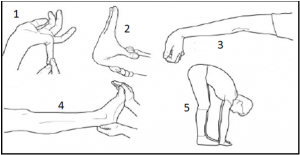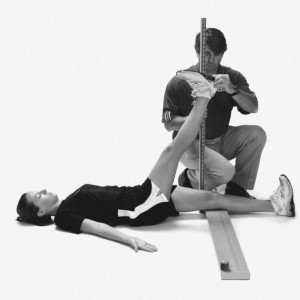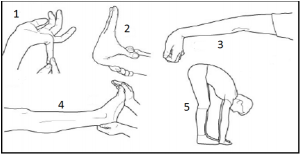Last week Okanagan Peak Performance Inc hosted a seminar for the gymnastics community. The title was The Most Important Ability for Gymnasts - What it is and how to improve it. Below is a brief recap of the seminar.Probably about 15 years ago I did a clinic for Pacific Sport on speed and agility. This was a short clinic for a number of athletes in their teens from a variety of sports. One of the athletes, Jordy, really stood out during the clinic and later I began coaching her and she eventually came to work for us.That was the first time I had worked with a gymnast. And a few things stood out right away. Gymnasts are really hard working. Gymnasts have really high relative strength. In other words their strength per body mass is excellent. Gymnasts tend to be hyper-mobile. Gymnasts tend to injured quite often.It was this last feature of gymnasts that was the inspiration for this presentation.You see, gymnasts tend to get injured. A lot.It's especially high when you consider gymnastics is a non-contact/non-collision sport it's unfortunate to see the high injury rate among gymnasts. You might expect to see injured athletes in football, rugby or hockey where an opponent is trying to run through you.In terms of gymnastics injuries, these are more commonly chronic rather than acute. This means the injury is the result of a pattern over time. Acute injuries can be traced back to a specific episode such as a fall or awkward landing.With male gymnasts the hands and wrists are the more commonly injured joints. This can the result of high speeds and loads being borne by the hands and wrists in an awkward position. Sometimes landings or transitions are one hand at a time doubling the force on these joints compared to when both...
Stretch For Increased Strength Gains
- Chris Collins
- Fitness
- 1811 Hits
- 0 Comments
-
Did you ever have quizzes when you were in school?I'm talking about surprises quizzes that were given without advance notice.[caption id="attachment_5529" align="aligncenter" width="300"] Pop quizzes were a good way to assess how well the class learned the basics.Usually they didn't count much toward your final grade but were important to get a quick pulse on how the class was doing. Did they learn the previous lesson? Can the teacher proceed with more advanced concepts?In other words, does the class understand the basics?Well, guess what it's quiz time!And the question is what is something most people want when it comes to their training but will neglect as well?The answer of course is stretching.And I would guess the reason stretching gets little attention is that it's not as appealing as a good strength or energy system training session.Bodybuilders, power and Olympic lifters all like the pump after a good lift.Aerobic athletes seek out 'the high' they get from a good ride, run, hike or swim.And once we've gotten what we need out of the training session there isn't much interest in stretching. It gets pushed to the side and ignored.But the irony is more and more people identify flexibility and mobility as their goal for training. Maybe they have restricted mobility which impacts their quality of life. For example, maybe a lack of shoulder mobility impairs an individual's ability to sleep at night. They may have nagging low back pain from tight hips and a weak core.So we know what we need but for whatever reason we are reluctant to give stretching and mobility the attention it deserves in our training program.This may be partly due to the fact most people train for a fat loss goal. They train to look better. They train to change the aesthetic which then helps with confidence and...
Foam Roll & Stretch For the Best Result
- Chris Collins
- Fitness
- 1561 Hits
- 0 Comments
-
The little things really do make all the difference. You see examples of this repeatedly throughout history. Think about this in terms of sports performance. The 'greats' weren't usually the most gifted. They weren't freaks in the weight room. For example, none of the following are household names: Justin Ernest, Stephen Paea, Mike Kudla, Mitch Petrus, Leif Larsen, Brodrick Bunkley, Jeff Owens, Dontari Poe, Scott Young, Kyle Harrington... Do any of these names ring a bell? Don't worry if they don't but they are the NFL Combine bench press record holders. Contrast this with Peyton Manning. His level of preparation for games was meticulous. Before a Super Bowl he would watch all 16 regular season games the opponent had played. And he had the back-up watch the 4 pre-season games and give him a report on what they were doing. He kept notes himself of what worked and what could be better. And then he made the appropriate adjustments and corrections based on this study and preparation. What about regular Joes like you and I? Does preparation matter? Absolutely it does! All I need to do is go back about 5 years to a powerlifting competition where I missed a deadlift attempt at 385 lbs. My previous effort in that competition was 365 lbs so that is where I finished for that lift. That was disheartening. At that point I felt like maybe strength was going to be a thing of the past for me. Maybe I would have to adjust my training? Maybe I would get into the sports and activities that guys in their 40s and 50s do? Maybe my best was now in the rear-view mirror? [caption id="attachment_5459" align="aligncenter" width="300"] Was this going to be my new sport? This was a bitter pill to swallow. But I was...
Back Spasms to Squats in 20 Min
The other day a client walked past the front desk and said 'I'm done. My back is spasming and I can't train today'. I could see the pain and disappointment in this young athlete's eyes. She was a dedicated athlete and was upset with only the physical pain but also with the thought of not being able to move without pain. I asked her if she has a few minutes to check what was wrong. I should clarify that this wasn't an attempt to diagnose an injury. Instead I wanted to take a look at her movement patterns to see how she was moving and how this might be affecting her low back. The first thing we looked at was her overhead squat pattern. This was a bodyweight assessment and she was ok to get into the set up position. However as she began to squat she winced and said her back spasmed. I asked her if it hurt standing, when she began to descent or at a certain depth. She said it was at a certain depth. The next thing I had her do was get on the ground on her back to see if she could hug her knees to her chest. She could and it didn't aggravate her back. This was interesting to note because she couldn't achieve the same knee and hip flexion from a standing position. After the knee hug test I asked her to keep both knees straight and lift one leg as high as she could. She raised one leg a few inches off the ground and repeated the same for the other leg. This was unusual as typically we look to see 80 degrees of hip flexion on this test. Right now this athlete was demonstrating 10 degrees. Maybe. When I asked the...
Why stretching might be bad for you
It seems like there are certain things in life where there isn't such a thing as too much of a good thing.You know what I mean?For example, not too many people would say no to a raise at work. Or a few extra days on a vacation. Or to any of the things we work to achieve and be rewarded with.In the same way in fitness we can sometimes see certain aspects of training as being not only essential for everyone but that it would be impossible to do too much of them.Usually this goes hand in hand with the things we don't like to do during our training. This may include a proper warm up, or core training, energy system training or maybe even stretching.For many stretching tends to be the element of their training that gets neglected. We put in the reps and sets or go for our runs but then skip the cool down and post-workout stretch. I know I am guilty of this.And as we age and settle into jobs where we sit for a big part of the day and we notice a change in our mobility. It gets harder to touch our toes. We can't reach our arm behind us to scratch our back. Basically we notice that aren't as flexible as we once were.And we recognize the need for increased mobility and stretching to achieve this.But this may not be the best solution for everyone.Last fall I attended a clinic with Eric Cressey presenting in Seattle. (Graeme was at this event as was Megan). Anyways Eric talked about using a series of tests to the assess the mobility (or hyper mobility) of athletes using the Beighton Test.[caption id="attachment_3894" align="alignleft" width="300"] The 5 Beighton testsThe image above shows the 5 tests which involve:* bending the...
6 Benefits of Proper Diaphragmatic Breathing
- Chris Collins
- Fitness
- 2135 Hits
- 4 Comments
-
There's been lots of discussion recently regarding diaphragmatic breathing. Some people are aware of the benefits of this type of breathing and others are probably thinking 'what's the big deal?' At a recent conference in California one of the more veteran presenters at a round table discussion said he didn't understand the big deal everyone was making about breathing. And I can kind of see his point. Sometimes we can get caught up in the minutiae of training and lose focus on the big picture. But in this case breathing is the basis for everything we do. It provides feedback as to the state of our nervous system, the effectivenss of our gas exchange and whether we are leaving anything on the table during athletic performance. But it's more than that. Because 20, 30 or 40 years ago we didn't sit and drive as much as do today. And we didn't specialize in one sport or activity as much as we see going on today. And maybe we lived simpler lives and didn't carry all of the stress that we do now in 2013. So we would therefore expect there to be differences in our posture, our mobility, the type and severity of the injuries we suffer as well as how much stress we are under. As a result there would be benefits to ensuring that we are breathing properly. In fact below are 6 Benefits of Proper Diaphragmatic Breathing. Diaphragmatic Breathing Benefit #1 - Better Gas ExchangeInstead of breathing maybe we should say respiration because with every breath we take in oxygen and exhale carbon dioxide. If we repsire, as many people do thoracically, we see the shoulders rise up towards the ears and the neck and traps contract. ***quick aside...The new Twilight movie involves the main character Bella getting...




